Content
- 1 Features of the wet facade system
- 2 Advantages and disadvantages
-
3 Types of wet facade
- 3.1 Heavy
- 3.2 Light
- 4 Main nodes
- 5 Types of insulation
- 6 Recommendations for choosing a finishing material
- 7 Possible errors during the work
- 8 Service life and repair
- 9 Video
- 10 Photo finish wet facade
The classic material used for the construction of private houses is brick. It has many advantages, but the brick also has disadvantages. Among them, high thermal conductivity and a tendency to accumulate moisture. To maintain the integrity of the brick walls and ensure comfort inside the building, a wet facade is being finished, and how to implement this technology with your own hands will be described below.
Features of the wet facade system
The facade of the cottage can be decorated in different ways. Amid a wide variety of technologies, the wet facade system stands out. What is such a method of warming and protecting the external walls of residential buildings and industrial buildings from the effects of negative factors?
Warming houses for various purposes by this technology involves coating the external walls with a moisture and frost-resistant material, and then plastering and painting the facade. Also, instead of using plaster and paint, special decorative panels can be used or clinker tiles finished. Let us describe the layered structure of such a cladding in the table.
| Layer | Consists of | Appointment |
| Heat insulating | Insulation material, adhesive mixture and dowels | Provides the facade of residential buildings with high heat and sound insulation qualities |
| Kleiarmirovat | Glue mixture, reinforcing mesh, soil | It provides the cladding of a residential building with strength, wear resistance, durability, high external aesthetics |
| Decorative finishing | Decorative plaster, panels, other decorative materials | This design gives the structure an attractive appearance, acts as additional protection for its walls from external influences. |
In other words, such a system is a complex layered structure, due to which the external walls of the residential building are provided with reliable protection.

Advantages and disadvantages
Finishing the exterior walls of residential cottages with a wet method in recent years has been in great demand, as it has a number of advantages:
- provides a facade of the house high resistance to wear, durability, practicality. Such a system serves without losing its properties for more than 25 years;
- A significant advantage of such a facade system is its affordable cost. In the case of the use of expanded polystyrene, sq m of facing will cost 1,500-2,000 rubles, and when using mineral wool, the price will double. However, other methods of facing the external walls of residential buildings, which would have similar operational parameters and practically had no shortcomings, will cost you many times more;
- warming the house in a similar way makes it warmer, more comfortable for living. Thanks to this decoration, a healthy microclimate is formed inside the home, which positively affects the well-being of each family member. In addition, the positive quality of the wet facade of the house is called the possibility of saving on the cost of electric or gas heating. And if you still carry out the insulation of windows, then no frost will be scary to you;
- the fact that the insulation is mounted on the walls from the outside allows you to save precious square meters of living space inside the building and even in those places where there is a window;
- due to the light weight of such a cladding, it can be used without additional strengthening of the foundation and walls of the house;
- relatively easy implementation in practice without the help of professional builders;
- using such technology, the finished house looks incredibly attractive, and its design successfully fits into the surrounding landscapes. Also note that after some time, if desired, the finish layer of the cladding can be replaced or updated.

Note that for a wet facade, some disadvantages are also characteristic. For example, it is not recommended to finish the facade and carry out its insulation work if the air temperature drops below 5 ° Celsius. In addition, it is not necessary to equip the facade in this way if the level of humidity is increased or there is precipitation. Such weather events prevent uniform drying of the cladding layers.
Types of wet facade
Finishing private houses using wet facade technology can be done with your own hands. But before starting work, you need to decide what its type is relevant for the walls of your home:
- heavy - the name reflects the main difference between the facade of a similar plan: significant weight, which limits the possibility of using this technology;
- lightweight - the technology can be applied to the walls of private houses built from any building material.


Heavy
In view of the rather high weight of such a finish, it is relevant to apply it to walls of those building materials, which can cope with such a high weight load: brick, cellular concrete or expanded clay concrete blocks.
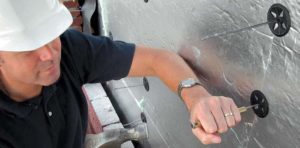
A distinctive feature of a heavy-type wet facade system is the fixation of thermal insulation without the use of an adhesive. The insulation is fixed on the base by means of special dowels with hooks. They are installed on the wall, only then they are mounted on a plate-type insulation material. The heat-insulating layer is additionally fixed by means of a reinforcing metal mesh, and then a stucco mortar is applied and finishing is carried out.
Due to the fact that the metal mesh needs to be masked, the plaster layer turns out to be thick, heavy. Hence the name of the cladding method.
Light
This method is quite common, as it is affordable and easy to implement in practice. The weight of the structure is minimal, so it is applicable to walls built from almost all standard materials: brick, concrete, foam concrete, stone, wood and so on.
The wet facade system in light type involves the use of finishing materials in several layers:
- the first layer of plaster will be the base and will allow the use of reinforcing mesh to give the cladding additional strength;
- the second layer of plaster will be leveling and will give the base a perfect evenness;
- the third layer (finish) can be made with different finishing materials: paint, decorative bark beetle plaster, siding, decorative panels, and the like. The main thing is that the selected option has the lowest possible weight.

Note that the facade decoration of the light type should be carried out by means of a finely dispersed and breathable plaster mixture. And the total thickness of the layers of the entire cladding, including on the slopes of the windows, should not exceed 10 mm.
Main nodes
To date, wet facade decoration is used most actively, due to the large number of advantages inherent in this type of decoration. By itself, this technology is a multilayer structure, each of the layers of which is aimed at fulfilling its function:
- the first is the wall of the building, which, before starting work, must undergo a certain preparation, which consists in leveling and cleaning;
- the second is a heat-insulating material, in which foam or mineral wool can be used. The first option is cheaper, but the second is better;
- the third is a reinforcing lining, designed to protect the slabs during the further finishing process;
- the fourth is a decorative layer for which decorative plaster or other finishing materials can be used.

Types of insulation
An important stage in the implementation of wet facade technology is the choice of insulation material. What material is best used for this purpose? In most cases, craftsmen use mineral wool in the form of plates. This is a fairly tough material, the density of which exceeds the figure of 150 kg / m³. Also often used to decorate facades in this way is polystyrene. The main thing is to choose the right brand (at least 35).
When comparing these two heaters, experts note that the mineral wool is the best option, because it is resistant to fire and is highly breathable, which is extremely important in the case of stone walls houses. When mineral wool is insulated, moisture from the masonry freely exits through the pores of the material, which allows recreate the optimal microclimate inside the home and significantly improve the thermal insulation parameters facade. If the budget for repairs is extremely limited, then you should prefer a cheaper foam.
Remember, it is worth choosing exclusively products from trusted manufacturers with a well-known name, the quality of products of which is documented. Then the facade will definitely be durable and resistant to wear.


Recommendations for choosing a finishing material
When arranging a wet facade, attention should be paid to the selection of finishing material. To facilitate the task, we offer you to carefully familiarize yourself with the possible facade systems that are ideal for such finishes:
- organic - with this method of decoration you will need expanded polystyrene boards, organic reinforcing mass, organic or silicone plaster;
- mineral - in this case, mineral plates are suitable for insulation, and mineral mixtures are suitable for reinforcement. As for the decorative layer, it is worth choosing silicate or mineral plaster;
- combined - in such a facade system both polystyrene foam and mineral materials are used. The first is suitable as insulation, and other materials can be used for reinforcement and subsequent plastering.
Separately, it is worth stopping at the choice of suitable adhesive compositions. The best option for a wet facade will be glue Cerezit SM-11. As for plaster, the most suitable are species such as a fur coat or bark beetle.

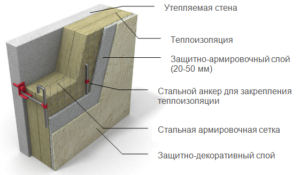

Possible errors during the work
When installing a wet facade, a number of errors are often made that adversely affect the quality of the coating:
- ignoring the temperature conditions of the work - this can cause destruction, delamination and even rotting of the layers of the system;
- improper preparation of the main layer - the service life will be significantly reduced due to destruction inside;
- the appearance of air gaps between the seams and layers, which can occur in the window area, will lead to cracks on the facade surface and the building design will be damaged
- improper installation of the reinforcing mesh - will cause chips and cracks in the outer layer.


Service life and repair
The facade, finished with a wet method can last up to 30 years. But this period may well vary up or down, which depends on humidity, climatic conditions and possible temperature differences.
During operation, the wet facade can be repaired if necessary. But for this it is necessary to save documents for all construction materials, so that if it is necessary to paint a certain area, purchase the previously used paint. Otherwise, you can not guess with a shade and then a prominent spot will appear on your facade.
If after a while you notice that in a certain area a piece of plaster began to peel off, which is especially often near windows, then in this case it is worthwhile to carry out the following work: clean this place to a strong layer, prime and apply a new layer plasters.
Video
To better understand the principle of the wet facade, we recommend watching the video.
Photo finish wet facade
In the selection of photos you can see how the finish looks like according to the wet facade system.





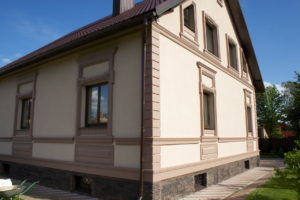



-
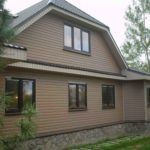 Facade of a house for siding, tips and options
Facade of a house for siding, tips and options
-
 The design of the facades of one-story houses, photo examples
The design of the facades of one-story houses, photo examples
-
 Finishing the facades of private houses with bark beetle plaster, photo options
Finishing the facades of private houses with bark beetle plaster, photo options
-
 Facing brick for facade decoration, its options
Facing brick for facade decoration, its options
-
 Advantages and disadvantages of ventilated facades made of composite panels
Advantages and disadvantages of ventilated facades made of composite panels
-
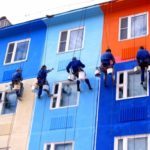 How to paint the facade and is it possible to do it
How to paint the facade and is it possible to do it
-
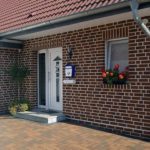 Methods of decorating the facade of the house with clinker tiles
Methods of decorating the facade of the house with clinker tiles
-
 The design of the facades of two-story houses, photo options
The design of the facades of two-story houses, photo options
-
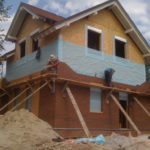 Facades for SIP houses, possible finishes
Facades for SIP houses, possible finishes
-
 Types of facades of private houses, photo examples
Types of facades of private houses, photo examples
-
 How to create a beautiful Moorish lawn
How to create a beautiful Moorish lawn
-
 Why strongly recommend linen bedding
Why strongly recommend linen bedding
New publications are published daily on our channel in Yandex. Zen
Go to Yandex. Zen



